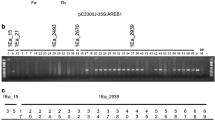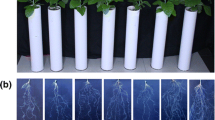Abstract
The development of drought tolerant plants is a high priority because the area suffering from drought is expected to increase in the future due to global warming. One strategy for the development of drought tolerance is to genetically engineer plants with transcription factors (TFs) that regulate the expression of several genes related to abiotic stress defense responses. This work assessed the performance of soybean plants overexpressing the TF DREB1A under drought conditions in the field and in the greenhouse. Drought was simulated in the greenhouse by progressively drying the soil of pot cultures of the P58 and P1142 lines. In the field, the performance of the P58 line and of 09D-0077, a cross between the cultivars BR16 and P58, was evaluated under four different water regimes: irrigation, natural drought (no irrigation) and water stress created using rain-out shelters in the vegetative or reproductive stages. Although the dehydration-responsive element-binding protein (DREB) plants did not outperform the cultivar BR16 in terms of yield, some yield components were increased when drought was introduced during the vegetative stage, such as the number of seeds, the number of pods with seeds and the total number of pods. The greenhouse data suggest that the higher survival rates of DREB plants are because of lower water use due to lower transpiration rates under well watered conditions. Further studies are needed to better characterize the soil and atmospheric conditions under which these plants may outperform the non-transformed parental plants.





Similar content being viewed by others
References
Aragão FJL, Sarokin L, Vianna GR, Rech EL (2000) Selection of transgenic meristematic cells utilizing an herbicidal molecule results in recovery of fertile transgenic soybean [Glycine max (L.) Merril] plants at a high frequency. Theor Appl Gen 101:1–6
Behnam B, Kikuchi A, Celebi-Toprak F, Yamanaka S, Kasuga M, Yamaguchi-Shinozaki K, Watanabe KN (2006) The Arabidopsis DREB1A gene driven by the stress-inducible rd29A promoter increases salt-stress tolerance in proportion to its copy number in tetrasomic tetraploid potato (Solanum tuberosum). Plant Biotech J 23:169–177
Bhatnagar-Mathur P, Devi MJ, Serraj R, Yamaguchi-Shinozaki K, Vadez V, Sharma KK (2004) Evaluation of transgenic groundnut lines under water limited conditions. Int Arachis Newslett 24:33–34
Bhatnagar-Mathur P, Devi MJ, Reddy DS, Lavanya M, Vadez V, Serraj R, Yamaguchi-Shinozaki K, Sharma KK (2007) Stress-inducible expression of AtDREB1A in transgenic peanut (Arachis hypogaea L.) increases transpiration efficiency under water-limiting conditions. Plant Cell Rep 26:2071–2082
Blum A (2005) Drought resistance, water-use efficiency, and yield potential are they compatible, dissonant, or mutually exclusive? Aust J Agric Res 56:1159–1168
Conab—Companhia Nacional de Abastecimento (2005) Available at http://www.conab.gov.br
Conab—Companhia Nacional de Abastecimento (2012) Available at http://www.conab.gov.br
Crusiol LGT, Carvalho JFC, Farias JRB (2012) Análise da disponibilidade hídrica na fazenda da Embrapa Soja (Londrina, PR) nas safras de 2009/2010, 2010/2011 e 2011/2012, 99–107
Dubouzet JG, Sakuma Y, Ito Y, Kasuga M, Dubouzet EG, Miura S, Seki M, Shinozaki K, Yamaguchi-Shinozaki K (2003) OsDREB genes in rice, Oryza sativa L. encode transcription activators that function in drought-, high-salt- and cold-responsive gene expression. Plant J 33:751–763
Embrapa—Empresa Brasileira de Pesquisa Agropecuária (2004) Available at http://www.cnpso.embrapa.br
Embrapa—Empresa Brasileira de Pesquisa Agropecuária (2011) Available at http://www.cnpso.embrapa.br
Fehr WR, Caviness CE, Burmood DT, Pernnigton JS (1971) Stage of development description for soybeans [Glycine max (L.) Merrill]. Crop Sci 11:929–931
Flexas J, Bota J, Loreto F, Cornic G, Sharkey TD (2004) Diffusive and metabolic limitations to photosynthesis under drought and salinity in C3 plants. Plant Biol 6:269–279
Gao SQ, Chen M, Xia LQ, Xiu HJ, Xu ZS, Li LC, Zhao CP, Cheng XG, Ma YZ (2009) A cotton (Gossypium hirsutum) DRE binding transcription factor gene, GhDREB, confers enhanced tolerance to drought, high salt, and freezing stresses in transgenic wheat. Plant Cell Rep 28:301–311
Hufstetler EV, Boerma HR, Carter TE, Earl HJ (2007) Genotypic variation for three physiological traits affecting drought tolerance in soybean. Crop Sci 47:25–35
Kasuga M, Liu Q, Miura S, Yamaguchi-Shinozaki K, Shinozaki K (1999) Improving plant drought, salt, and freezing tolerance by gene transfer of a single stress inducible transcription factor. Nat Biotech 17:287–291
Kasuga M, Miura S, Shinozaki K, Yamaguchi-Shinozaki K (2004) A Combination of the Arabidopsis DREB1A gene and stress-inducible rd29A promoter improved drought- and low-temperature stress tolerance in tobacco by gene transfer. Plant Cell Physiol 45:346–350
Li XP, Tian AG, Luo GZ, Gong ZZ, Zhang JS, Chen SY (2005) Soybean DRE-binding transcription factors that are responsive to abiotic stresses. Theor Appl Genet 110:1355–1362
Liu Q, Kasuga M, Sakuma Y, Abe H, Miura S, Yamaguchi-Shinozaki K, Shinozaki K (1998) Two transcription factors, DREB1 and DREB2, with an EREBP/AP2 DNA binding domain separate two cellular signal transduction pathways in drought-and low temperature-responsive gene expression, respectively, in Arabidopsis. Plant Cell 10:1391–1406
Lopato S, Langridge P (2011) Engineering Stress Tolerance in Cereals Using DREB/CBF Genes: Outcomes. Problems and Perspectives, ISB News Rep
Morran S, Eini O, Pyvovarenko T, Parent B, Singh R, Ismagul A, Eliby S, Shirley N, Langridge P, Lopato S (2011) Improvement of stress tolerance of wheat and barley by modulation of expression of DREB/CBF factors. Plant Biotech J 9:230–249
Oh SJ, Song SI, Kim YS, Jang HJ, Kim SY, Kim M, Kim YK, Nahm BH, Kim JK (2005) Arabidopsis CBF3/DREB1A and ABF3 in transgenic rice increased tolerance to abiotic stress without stunting growth. Plant Physiol 138:341–351
Oya T, Nepomuceno AL, Neumaier N, Farias JRB, Tobita S, Ito O (2004) Drought tolerance characteristics of Brazilian soybean cultivars—evaluation and characterization of drought tolerance of various Brazilian soybean cultivars in the field. Plant Prod Sci 7:129–137
Passioura JB (2012) Phenotyping for drought tolerance in grain crops: when is it useful to breeders? Funct Plant Biol 39:851–859. doi:10.1071/FP12079
Pellegrineschi A, Reynolds M, Pacheco M, Brito RM, Almeraya R, Yamaguchi-Shinozaki K, Hoisington D (2004) Stress-induced expression in wheat of the Arabidopsis thaliana DREB1A gene delays water stress symptoms under greenhouse conditions. Genome 47:493–500
Pinto RS, Reynolds MP, Mathews KL, McIntyre CL, Olivares-Villegas JJ, Chapman SC (2010) Heat and drought adaptive QTL in a wheat population designed to minimize confounding agronomic effects. Theor Appl Genet 121:1001–1021
Polizel AM, Medri ME, Nakashima K et al (2011) Molecular, anatomical and physiological properties of a genetically modified soybean line transformed with rd29A:AtDREB1A for the improvement of drought tolerance. Genet Mol Res 10:3641–3656
Qin F, Sakuma Y, Li J, Liu Q, Li YQ, Shinozaki K, Yamaguchi-Shinozaki K (2004) Cloning and functional analysis of a novel DREB1/CBF transcription factor involved in cold-responsive gene expression in Zea mays L. Plant and Cell Physiol 45:1042–1052
Ray JD, Sinclair TR (1997) Stomatal closure of maize hybrids in response to soil drying. Crop Sci 37:803–807
Rech EL, Vianna GR, Aragão FJL (2008) High-efficiency transformation by biolistics of soybean, common bean and cotton transgenic plants. Nat Protoc 3:1–10
Richards RA (1991) Crop improvement for temperate Australia—future opportunities. Field Crops Res 26:141–169
Saint Pierre C, Crossa JL, Bonnett D, Yamaguchi-Shinozaki K, Reynolds MP (2012) Phenotyping transgenic wheat for drought resistance. J Exp Bot 63:1799–1808
Thornthwaite CW, Mather JR (1955) The water balance. Drexel Institute of Technology - Laboratory of Climatology, Centerton, p 104p
Vadez V, Sinclair TR (2001) Leaf ureide degradation and N2 fixation tolerance to water deficit in soybean. J Exp Bot 52:153–159
Vadez V, Rao S, Sharma KK, Bhatnagar Mathur P, Devi JM (2007) DREB1A allows for more water uptake in groundnut by a large modification in the root/shoot ratio under water deficit. Int Arachis Newslett 27:27–31
Vadez V, Rao JS, Bhatnagar-Mathur P, Sharma KK (2013) DREB1A promotes root development in deep soil layers and increases water extraction under water stress in groundnut. Plant Biol 15:45–52
Wright G (1996) Review of ACIAR selection for water use efficiency in legumes project recommends further research. ACIAR Food Legume Newslett 1996:2–3
Xiao B, Chen X, Xiang C, Tang N, Zhang Q, Xiong L (2009) Evaluation of seven function-known candidate genes for their effects on improving drought resistance of transgenic rice under field conditions. Mol Plant 2:73–83
Yang S, Vanderbeld B, Wan J, Huang Y (2010) Narrowing down the targets: towards successful genetic engineering of drought tolerant crops. Mol Plant 3:469–490
Acknowledgments
This work was supported by the Science and Technology Research Partnership for Sustainable Development (SATREPS) of the Japan Science and Technology Agency/Japan International Cooperation Agency, JIRCAS, Empresa Brasileira de Pesquisa Agropecuária, Coordenação de Aperfeiçoamento de Pessoal de Nível Superior (CAPES), Londrina State University (UEL)/Brazil.
Author information
Authors and Affiliations
Corresponding author
Additional information
Communicated by: Amanda Alves de Paiva Rolla.
Josirley de Fátima Corrêa Carvalho and Amanda Alves de Paiva Rolla made equal contributions to this paper.
Electronic supplementary material
Below is the link to the electronic supplementary material.
Rights and permissions
About this article
Cite this article
de Paiva Rolla, A.A., de Fátima Corrêa Carvalho, J., Fuganti-Pagliarini, R. et al. Phenotyping soybean plants transformed with rd29A:AtDREB1A for drought tolerance in the greenhouse and field. Transgenic Res 23, 75–87 (2014). https://doi.org/10.1007/s11248-013-9723-6
Received:
Accepted:
Published:
Issue Date:
DOI: https://doi.org/10.1007/s11248-013-9723-6




